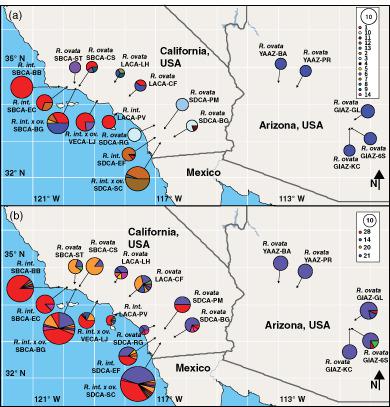当前位置:
X-MOL 学术
›
Plant Species Biol.
›
论文详情
Our official English website, www.x-mol.net, welcomes your
feedback! (Note: you will need to create a separate account there.)
Genetic, morphological, and niche variation in the widely hybridizing Rhus integrifolia‐Rhus ovata species complex
Plant Species Biology ( IF 1.1 ) Pub Date : 2020-09-15 , DOI: 10.1111/1442-1984.12293 Craig F. Barrett 1 , Joshua Lambert 1 , Mathilda V. Santee 1 , Brandon T. Sinn 2 , Samuel V. Skibicki 1 , Heather M. Stephens 3 , Hana Thixton 1
Plant Species Biology ( IF 1.1 ) Pub Date : 2020-09-15 , DOI: 10.1111/1442-1984.12293 Craig F. Barrett 1 , Joshua Lambert 1 , Mathilda V. Santee 1 , Brandon T. Sinn 2 , Samuel V. Skibicki 1 , Heather M. Stephens 3 , Hana Thixton 1
Affiliation

|
Hybridization and introgression are common processes among numerous plant species that present both challenges and opportunities for studies of species delimitation, phylogenetics, taxonomy and adaptation. Rhus integrifolia and R. ovata are two ecologically important shrubs native to the southwestern USA and Mexico, and are known to hybridize frequently, but the morphological, genetic and ecological implications of hybridization in these species are poorly studied on a broad geographic scale. Analyses were conducted using leaf morphology, genetic variation of plastid and nuclear loci, and species distribution models for both species and their putative hybrid introgressants across 19 localities in California and Arizona, USA. These analyses revealed evidence for morphological and genetic distinction among localities comprising putative parental species, but a high degree of morpho‐genetic intermediacy among localities with putative hybrids. Comparison of morphological and genetic population structure among localities revealed evidence for putative local adaptation or widespread phenotypic plasticity. Multiple regression models identified a weak but statistically significant negative association between leaf area and precipitation. Finally, species distribution modeling inferred northward range shifts over time, with both species predicted to occupy more coastal regions in the future, possibly increasing the frequency of hybridization among them. These findings underscore the importance of integrative assessment of multiple data sources in the study of hybridizing species and highlight the R. integrifolia‐ovata complex as a powerful model for investigating the adaptive implications of hybridization.
中文翻译:

广泛杂交的Rhus integrifolia-Rhus ovata物种复合体的遗传,形态和生态位变异
杂交和渗入是众多植物物种之间的共同过程,为研究物种定界,系统发育,分类学和适应性带来了挑战和机遇。漆树integrifolia的和R.卵形这是两种原产于美国西南部和墨西哥的具有重要生态意义的灌木,已知经常杂交,但是在这些物种中杂交的形态,遗传和生态意义在广泛的地理范围内研究较少。使用叶片形态,质体和核基因座的遗传变异以及物种及其在美国加利福尼亚州和亚利桑那州19个地区的推定杂种渐渗种的物种分布模型进行了分析。这些分析揭示了由推测的亲本物种组成的地区之间在形态和遗传上的区别的证据,但是在具有推测的杂种的地区之间存在很高的形态遗传中间性。地方之间的形态和遗传种群结构的比较揭示了假定的局部适应或广泛的表型可塑性的证据。多元回归模型确定了叶面积与降水之间的微弱但统计学上显着的负相关。最后,物种分布模型可以推断出北方物种随时间推移而发生的变化,预计这两种物种未来都将占据更多的沿海地区,这可能会增加它们之间杂交的频率。这些发现强调了在杂交物种研究中对多种数据源进行综合评估的重要性,并强调了 物种分布模型可以推断出北方物种随时间推移的变化,预计这两种物种将来都将占据更多的沿海地区,这可能会增加它们之间杂交的频率。这些发现强调了在杂交物种研究中对多种数据源进行综合评估的重要性,并强调了 物种分布模型可以推断出北方物种随时间推移的变化,预计这两种物种将来都将占据更多的沿海地区,这可能会增加它们之间杂交的频率。这些发现强调了在杂交物种研究中对多种数据源进行综合评估的重要性,并强调了R. integrifolia-ovata复合体是研究杂交适应性影响的强大模型。
更新日期:2020-09-15
中文翻译:

广泛杂交的Rhus integrifolia-Rhus ovata物种复合体的遗传,形态和生态位变异
杂交和渗入是众多植物物种之间的共同过程,为研究物种定界,系统发育,分类学和适应性带来了挑战和机遇。漆树integrifolia的和R.卵形这是两种原产于美国西南部和墨西哥的具有重要生态意义的灌木,已知经常杂交,但是在这些物种中杂交的形态,遗传和生态意义在广泛的地理范围内研究较少。使用叶片形态,质体和核基因座的遗传变异以及物种及其在美国加利福尼亚州和亚利桑那州19个地区的推定杂种渐渗种的物种分布模型进行了分析。这些分析揭示了由推测的亲本物种组成的地区之间在形态和遗传上的区别的证据,但是在具有推测的杂种的地区之间存在很高的形态遗传中间性。地方之间的形态和遗传种群结构的比较揭示了假定的局部适应或广泛的表型可塑性的证据。多元回归模型确定了叶面积与降水之间的微弱但统计学上显着的负相关。最后,物种分布模型可以推断出北方物种随时间推移而发生的变化,预计这两种物种未来都将占据更多的沿海地区,这可能会增加它们之间杂交的频率。这些发现强调了在杂交物种研究中对多种数据源进行综合评估的重要性,并强调了 物种分布模型可以推断出北方物种随时间推移的变化,预计这两种物种将来都将占据更多的沿海地区,这可能会增加它们之间杂交的频率。这些发现强调了在杂交物种研究中对多种数据源进行综合评估的重要性,并强调了 物种分布模型可以推断出北方物种随时间推移的变化,预计这两种物种将来都将占据更多的沿海地区,这可能会增加它们之间杂交的频率。这些发现强调了在杂交物种研究中对多种数据源进行综合评估的重要性,并强调了R. integrifolia-ovata复合体是研究杂交适应性影响的强大模型。











































 京公网安备 11010802027423号
京公网安备 11010802027423号